Liberia’s Constitutional Referendum took place August 23rd, and was considered by many to be a dress rehearsal for the fast approaching presidential election. This Referendum was the first time since the civil war that Liberia’s National Elections Commission (NEC) ran the show rather than the UN; it was also a test for how effectively voter education activities had informed the population. And of great concern to Ushahidi Liberia and its partner organizations, it was a chance to see if violence would erupt and, if so, where and towards whom.
[caption id="attachment_5202" align="aligncenter" width="500" caption="Liberia 2011 election instance"]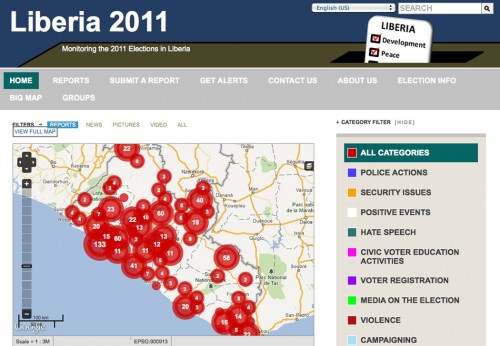 [/caption]
The Liberia 2011 election instance received 239 crowdseeded messages from trusted reporters during the Referendum and the following week before official results were announced. These reporters have received training in how to report to the Ushahidi platform using the free “2011” shortcode; among them are local election monitors, Liberian police officers, international election observers and local journalists. Most of the messages focused on the following: a low voter turnout (only about one-third of the voting population), a printing error on the ballot that confused voters about Proposition 2, the high number of incorrectly marked ballots (approximately 12% counted as invalid), the frustration of NEC workers over long hours without break and some incidents of violence. Overall, there were few violent incidents during and after the Referendum; those reported include one ritualistic killing with political motives, an attack on a political candidate as well as NEC staff counting ballots at night, and a few fights that broke out at polling stations over how to vote on the Referendum's four propositions.
[caption id="attachment_5200" align="aligncenter" width="500" caption="Sierra Leone's Election Watch and ECC observers"]
[/caption]
The Liberia 2011 election instance received 239 crowdseeded messages from trusted reporters during the Referendum and the following week before official results were announced. These reporters have received training in how to report to the Ushahidi platform using the free “2011” shortcode; among them are local election monitors, Liberian police officers, international election observers and local journalists. Most of the messages focused on the following: a low voter turnout (only about one-third of the voting population), a printing error on the ballot that confused voters about Proposition 2, the high number of incorrectly marked ballots (approximately 12% counted as invalid), the frustration of NEC workers over long hours without break and some incidents of violence. Overall, there were few violent incidents during and after the Referendum; those reported include one ritualistic killing with political motives, an attack on a political candidate as well as NEC staff counting ballots at night, and a few fights that broke out at polling stations over how to vote on the Referendum's four propositions.
[caption id="attachment_5200" align="aligncenter" width="500" caption="Sierra Leone's Election Watch and ECC observers"]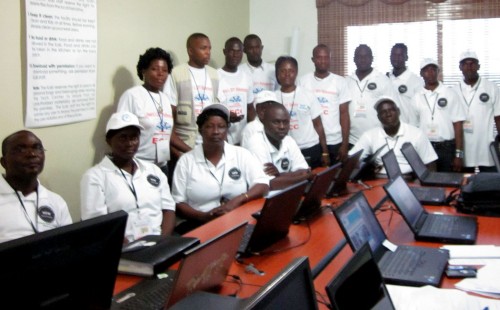 [/caption]
iLab Liberia, the tech lab at Ushahidi Liberia’s office, served as a data entry hub for the Elections Coordinating Committee and Sierra Leoneon observers during the Referendum, and in the days following each partner organization that received messages on the election instance used iLab’s facilities to verify and approve reports for public viewing. It became clear as we assisted partners with their data that polling station geo-coordinates were a must for the election instance. Our team realized this months ago, but were not able to locate a data set with more than the name and county location of each polling station.
[caption id="attachment_5201" align="aligncenter" width="500" caption="ECC Referendum observers entering incident reports into their database"]
[/caption]
iLab Liberia, the tech lab at Ushahidi Liberia’s office, served as a data entry hub for the Elections Coordinating Committee and Sierra Leoneon observers during the Referendum, and in the days following each partner organization that received messages on the election instance used iLab’s facilities to verify and approve reports for public viewing. It became clear as we assisted partners with their data that polling station geo-coordinates were a must for the election instance. Our team realized this months ago, but were not able to locate a data set with more than the name and county location of each polling station.
[caption id="attachment_5201" align="aligncenter" width="500" caption="ECC Referendum observers entering incident reports into their database"]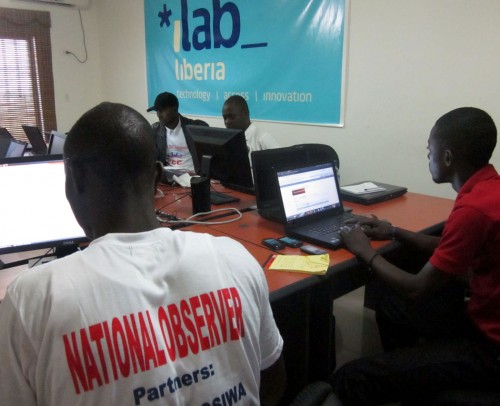 [/caption]
Once in a blue moon, data heroes come along when you need them most - and that was what happened the week after the Referendum when a UN officer who attended iLab's mapping party offered to share a KMZ file with each polling station’s confirmed latitude and longitude. A dream come true! But we ran into a familiar problem – we only had the coordinates and the stations' code numbers in this file. After a serendipitous trip to the NEC where I ran into the IT Director on his way out, he showed me the pdf with all the polling stations’ descriptive details – and, even better, it was online! But, as was the case with our KMZ file, a crucial piece of data was missing – the geo-coordinates. After a bit of tweaking and rearranging, our team merged the two data sets and placed them on the election instance.
[/caption]
Once in a blue moon, data heroes come along when you need them most - and that was what happened the week after the Referendum when a UN officer who attended iLab's mapping party offered to share a KMZ file with each polling station’s confirmed latitude and longitude. A dream come true! But we ran into a familiar problem – we only had the coordinates and the stations' code numbers in this file. After a serendipitous trip to the NEC where I ran into the IT Director on his way out, he showed me the pdf with all the polling stations’ descriptive details – and, even better, it was online! But, as was the case with our KMZ file, a crucial piece of data was missing – the geo-coordinates. After a bit of tweaking and rearranging, our team merged the two data sets and placed them on the election instance.
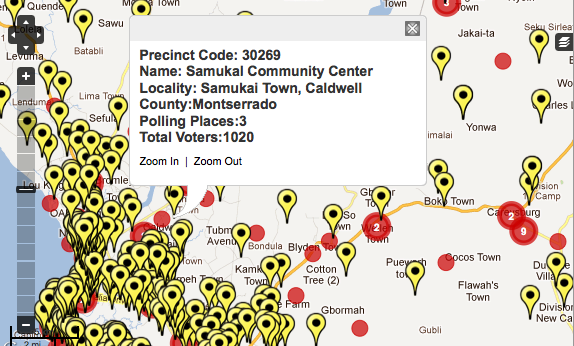 [caption id="attachment_5199" align="aligncenter" width="498" caption="Polling stations for Liberia's election"]
[caption id="attachment_5199" align="aligncenter" width="498" caption="Polling stations for Liberia's election"]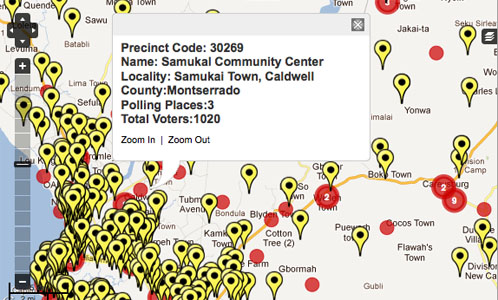 [/caption]
What is now displayed on the election instance constitutes the first complete online data set of all 1,780 polling stations and their exact locations. We may soon incorporate these stations into the “categories” section of the instance, but for now you can find them by clicking on the “polling stations” layer located just below categories. Each time you zoom in, it’s necessary to refresh the polling stations layer; when you do, and click on a station, you’ll see the station’s code, name of the building, town, county and total voters registered at that site. Other layers on this map include electoral district boundaries for quickly viewing how many reports and polling stations are located in each district.
One of the Referendum’s four propositions suggested a date change for the presidential election; official results revealed the date would stay the same – October 11th. That leaves a month between this dress rehearsal and the main event. The Ushahidi Liberia team is going to be busy preparing with up-country trips trainings for 200+ new reporters, turning iLab into the Elections Coordinating Committee’s situation room and making sure all systems are go for what is perhaps Liberia's most anticipated event since its first democratic election 6 years ago.
[/caption]
What is now displayed on the election instance constitutes the first complete online data set of all 1,780 polling stations and their exact locations. We may soon incorporate these stations into the “categories” section of the instance, but for now you can find them by clicking on the “polling stations” layer located just below categories. Each time you zoom in, it’s necessary to refresh the polling stations layer; when you do, and click on a station, you’ll see the station’s code, name of the building, town, county and total voters registered at that site. Other layers on this map include electoral district boundaries for quickly viewing how many reports and polling stations are located in each district.
One of the Referendum’s four propositions suggested a date change for the presidential election; official results revealed the date would stay the same – October 11th. That leaves a month between this dress rehearsal and the main event. The Ushahidi Liberia team is going to be busy preparing with up-country trips trainings for 200+ new reporters, turning iLab into the Elections Coordinating Committee’s situation room and making sure all systems are go for what is perhaps Liberia's most anticipated event since its first democratic election 6 years ago.
 [/caption]
The Liberia 2011 election instance received 239 crowdseeded messages from trusted reporters during the Referendum and the following week before official results were announced. These reporters have received training in how to report to the Ushahidi platform using the free “2011” shortcode; among them are local election monitors, Liberian police officers, international election observers and local journalists. Most of the messages focused on the following: a low voter turnout (only about one-third of the voting population), a printing error on the ballot that confused voters about Proposition 2, the high number of incorrectly marked ballots (approximately 12% counted as invalid), the frustration of NEC workers over long hours without break and some incidents of violence. Overall, there were few violent incidents during and after the Referendum; those reported include one ritualistic killing with political motives, an attack on a political candidate as well as NEC staff counting ballots at night, and a few fights that broke out at polling stations over how to vote on the Referendum's four propositions.
[caption id="attachment_5200" align="aligncenter" width="500" caption="Sierra Leone's Election Watch and ECC observers"]
[/caption]
The Liberia 2011 election instance received 239 crowdseeded messages from trusted reporters during the Referendum and the following week before official results were announced. These reporters have received training in how to report to the Ushahidi platform using the free “2011” shortcode; among them are local election monitors, Liberian police officers, international election observers and local journalists. Most of the messages focused on the following: a low voter turnout (only about one-third of the voting population), a printing error on the ballot that confused voters about Proposition 2, the high number of incorrectly marked ballots (approximately 12% counted as invalid), the frustration of NEC workers over long hours without break and some incidents of violence. Overall, there were few violent incidents during and after the Referendum; those reported include one ritualistic killing with political motives, an attack on a political candidate as well as NEC staff counting ballots at night, and a few fights that broke out at polling stations over how to vote on the Referendum's four propositions.
[caption id="attachment_5200" align="aligncenter" width="500" caption="Sierra Leone's Election Watch and ECC observers"] [/caption]
iLab Liberia, the tech lab at Ushahidi Liberia’s office, served as a data entry hub for the Elections Coordinating Committee and Sierra Leoneon observers during the Referendum, and in the days following each partner organization that received messages on the election instance used iLab’s facilities to verify and approve reports for public viewing. It became clear as we assisted partners with their data that polling station geo-coordinates were a must for the election instance. Our team realized this months ago, but were not able to locate a data set with more than the name and county location of each polling station.
[caption id="attachment_5201" align="aligncenter" width="500" caption="ECC Referendum observers entering incident reports into their database"]
[/caption]
iLab Liberia, the tech lab at Ushahidi Liberia’s office, served as a data entry hub for the Elections Coordinating Committee and Sierra Leoneon observers during the Referendum, and in the days following each partner organization that received messages on the election instance used iLab’s facilities to verify and approve reports for public viewing. It became clear as we assisted partners with their data that polling station geo-coordinates were a must for the election instance. Our team realized this months ago, but were not able to locate a data set with more than the name and county location of each polling station.
[caption id="attachment_5201" align="aligncenter" width="500" caption="ECC Referendum observers entering incident reports into their database"] [/caption]
Once in a blue moon, data heroes come along when you need them most - and that was what happened the week after the Referendum when a UN officer who attended iLab's mapping party offered to share a KMZ file with each polling station’s confirmed latitude and longitude. A dream come true! But we ran into a familiar problem – we only had the coordinates and the stations' code numbers in this file. After a serendipitous trip to the NEC where I ran into the IT Director on his way out, he showed me the pdf with all the polling stations’ descriptive details – and, even better, it was online! But, as was the case with our KMZ file, a crucial piece of data was missing – the geo-coordinates. After a bit of tweaking and rearranging, our team merged the two data sets and placed them on the election instance.
[/caption]
Once in a blue moon, data heroes come along when you need them most - and that was what happened the week after the Referendum when a UN officer who attended iLab's mapping party offered to share a KMZ file with each polling station’s confirmed latitude and longitude. A dream come true! But we ran into a familiar problem – we only had the coordinates and the stations' code numbers in this file. After a serendipitous trip to the NEC where I ran into the IT Director on his way out, he showed me the pdf with all the polling stations’ descriptive details – and, even better, it was online! But, as was the case with our KMZ file, a crucial piece of data was missing – the geo-coordinates. After a bit of tweaking and rearranging, our team merged the two data sets and placed them on the election instance.
 [/caption]
What is now displayed on the election instance constitutes the first complete online data set of all 1,780 polling stations and their exact locations. We may soon incorporate these stations into the “categories” section of the instance, but for now you can find them by clicking on the “polling stations” layer located just below categories. Each time you zoom in, it’s necessary to refresh the polling stations layer; when you do, and click on a station, you’ll see the station’s code, name of the building, town, county and total voters registered at that site. Other layers on this map include electoral district boundaries for quickly viewing how many reports and polling stations are located in each district.
One of the Referendum’s four propositions suggested a date change for the presidential election; official results revealed the date would stay the same – October 11th. That leaves a month between this dress rehearsal and the main event. The Ushahidi Liberia team is going to be busy preparing with up-country trips trainings for 200+ new reporters, turning iLab into the Elections Coordinating Committee’s situation room and making sure all systems are go for what is perhaps Liberia's most anticipated event since its first democratic election 6 years ago.
[/caption]
What is now displayed on the election instance constitutes the first complete online data set of all 1,780 polling stations and their exact locations. We may soon incorporate these stations into the “categories” section of the instance, but for now you can find them by clicking on the “polling stations” layer located just below categories. Each time you zoom in, it’s necessary to refresh the polling stations layer; when you do, and click on a station, you’ll see the station’s code, name of the building, town, county and total voters registered at that site. Other layers on this map include electoral district boundaries for quickly viewing how many reports and polling stations are located in each district.
One of the Referendum’s four propositions suggested a date change for the presidential election; official results revealed the date would stay the same – October 11th. That leaves a month between this dress rehearsal and the main event. The Ushahidi Liberia team is going to be busy preparing with up-country trips trainings for 200+ new reporters, turning iLab into the Elections Coordinating Committee’s situation room and making sure all systems are go for what is perhaps Liberia's most anticipated event since its first democratic election 6 years ago.